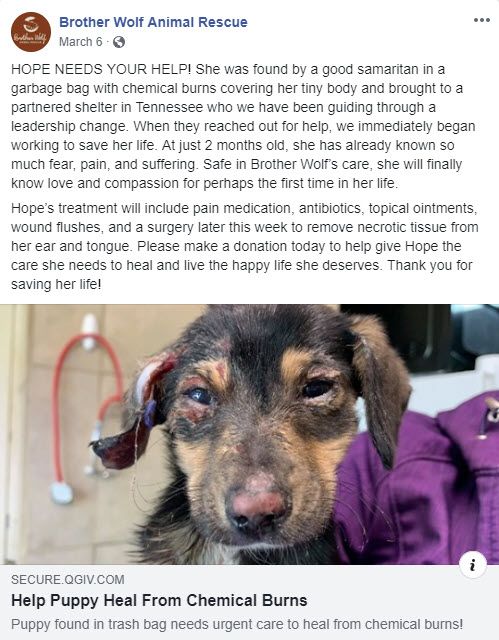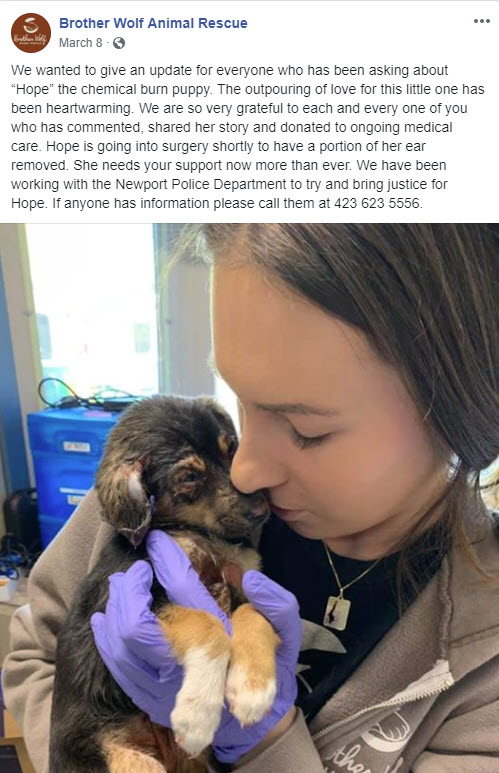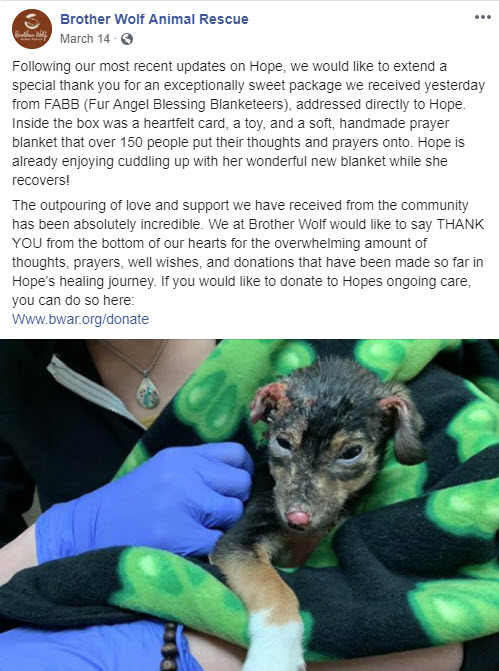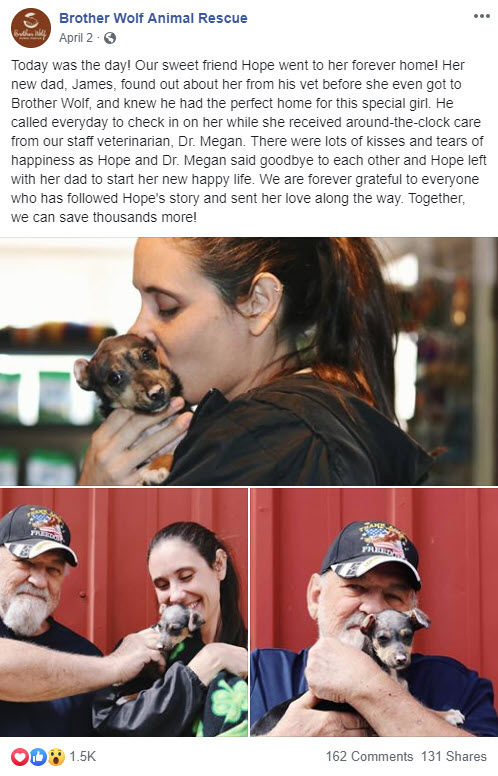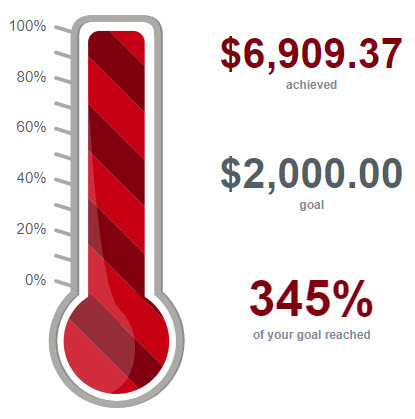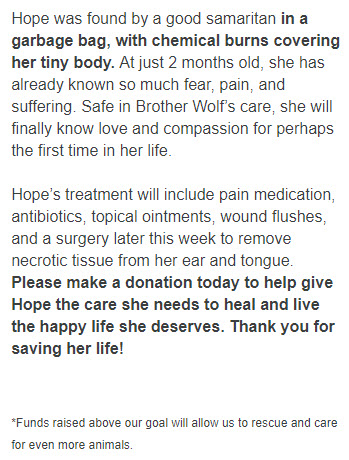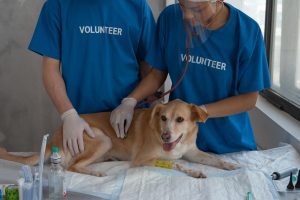Brother Wolf Animal Rescue is a nonprofit no-kill organization in Asheville, North Carolina. Their 10,000 sq.ft. Joyce B. Cambron Adoption Center is home to up to 100 dogs, puppies, cats, kittens, and small animals each day. Founded in 2007, Brother Wolf has helped create no-kill communities in multiple counties in North Carolina. They’ve expanded their services and formed several county chapters in North Carolina. In a short while, they’ve become a powerful force for change. Their success is due largely to their ability to tell compelling stories in a strategic, effective way. Their stories simply motivate their supporters to give. We’ve examined a recent Brother Wolf Animal Rescue campaign to save Hope, a puppy who needed extensive medical care. Now, we present you with actionable tips to help you find fundraising success through storytelling.
Share your story where supporters will see it
Brother Wolf Animal Rescue knows that their story about Hope shouldn’t solely exist on their website. Only telling stories on your nonprofit’s website means your supporters have to search for it. Instead, take your stories to where your supporters are likely spending the majority of their time: social media. Yes, Brother Wolf told the story of Hope the puppy on their site. But, they didn’t limit their storytelling to their website alone. Instead, they told Hope’s story and provided several updates on their Facebook page.
This was the first in a series of Facebook posts letting supporters know Brother Wolf needed help to save Hope. They draw you in right away by telling you where Hope was found, what condition she was in, and what treatment she’d need to survive. They included a picture of Hope so supporters could see exactly what their donations could do – save an innocent, suffering puppy. In the post, they asked their Facebook followers for help and thanked them for helping save her life. Most importantly, the post linked directly to the campaign donation page where people could get more details on Hope’s condition and treatment plan. Because they reached donors where they were, Brother Wolf drove a lot of traffic to their fundraising page.
If your audience is on social media, share your stories there. If you know your supporters prefer direct mail or text message communication, send your stories that way. The point is, you need to reach your audience where they are. One barrier to receiving donations for your cause is leaving it up to donors to find you. It’s easy to overcome this barrier. Reach out to your donors in the way they prefer. If you don’t know how to reach them, ask!
Don’t tell the whole story at once
Their first Facebook post shared all the details supporters needed to be familiar with Hope’s situation. But Brother Wolf didn’t stop there! In the case of Hope the puppy, the story was told as it unfolded. Brother Wolf Animal Rescue couldn’t tell the whole story at once because they had no idea what the outcome would be. While this was undoubtedly a stressful situation for Brother Wolf and the on-staff vet taking care of Hope, it also worked in their favor. Being able to provide regular updates helped keep supporters coming back to help. While Hope was receiving treatment, Brother Wolf provided four written updates and thanked two businesses who sent care packages to Hope. On top of that, Brother Wolf also shared a couple live video updates on Facebook. To make donors feel appreciated, in each of their updates they thanked those who helped.
The last Facebook update was almost a month after the first post about Hope. As you can see, the regular updates kept people engaged. Consequently, this post had 131 Shares, 162 Comments, and 1,500 likes. This outpouring of support on Facebook translated to incredible success in their campaign to save Hope. Because so many people were touched by this story, Brother Wolf exceeded their fundraising goal. In fact, they reached 345% of their goal!
Vary your storytelling format
Brother Wolf Animal Rescue provided more than just text updates and still photos. In the last section, we mentioned live video updates on Facebook. These weren’t big budget productions. The videos were shot live on a smartphone. However, this format allowed supporters to comment and ask questions live on Facebook as the organization’s Executive Director provided details. This strategy was effective but simple. Your organization can easily make videos to show donors your areas of greatest need or even demonstrate how their donations have helped. Below are links to videos uploaded to Facebook to provide updates and say thanks to Hope’s supporters. As you can see, these aren’t scripted and aren’t shot professionally.
Regardless of quality, these simple, short videos had a positive impact on their fundraising campaign.
Use authentic photos
As you can see from the posts above, Brother Wolf Animal Rescue didn’t use stock photos for this campaign. In fact, they didn’t so much as touch up the photos of Hope. Some photos of her were downright hard to look at because you could see her pain. However, seeing her injuries is exactly what made donors give to save her. If there’s a problem your organization is trying to fix in your community, show donors what you’re combating. Giving your followers a look at the wrongs you’re trying to make right inspires like-minded people to help. Showing people a problem (and giving them a specific way to help) makes it real. It’s a powerful strategy. Because of the power of authentic images, your organization can use them to raise more money or recruit volunteers easier.
That’s not to say every time you share a story you need to focus on the doom and gloom. Sometimes an unbiased look at the problem is the answer. However, you can’t forget to be hopeful. If every message is sad, your supporters will start feeling a bit gloomy. Taking time out to celebrate small victories and share photos of success and thanks will keep supporters coming back for more.
Need more convincing? Read our blog post comparing the use of stock photos to authentic photos.
Be transparent about what you need
When your organization offers a solution to the problems you try to solve, be sure donors know what they’re giving to when you make your appeal. Being transparent about the cost of Hope’s treatment on their campaign page showed donors exactly what was needed. Setting a treatment goal for Hope helped supporters visualize how much would be needed. You can emulate Brother Wolf Animal Rescue’s transparency by using a fundraising thermometer. Set it to the amount you need to fix the problem you’re addressing. But, don’t stop there! Next you have to tell donors why you set that specific goal amount. What are their donations going to accomplish? In the case of Hope the puppy, Brother Wolf shared that they needed money for pain medication, her surgery, and round-the-clock care Hope would need if she was going to survive.
Brother Wolf Animal Rescue went above and beyond by explaining what they’d do if they exceeded their fundraising goal – which they did. Because of their transparency and powerful storytelling, additional funds raised supported the rescue and care of even more animals.
Conclusion
Storytelling is both an art and a science. Because of this, you may be able to tell a story that tugs at donors’ heartstrings, but it may go unread. Your well-produced story won’t help if no one reads it. To be more effective, think strategically about how to reach your donors. Reach out to supporters where they are. Provide regular updates. Try storytelling with video or other unique formats. Use authentic, honest photos. Most importantly, be as transparent as possible with how funds will be used. Strategically telling Hope’s story helped Brother Wolf Animal Rescue raise more than they asked for. Your organization can use these tips to achieve greater fundraising success in your next campaign. Want more help to write a compelling story? This blog post will help!
Want a final update on Hope’s progress toward recovery? Good! Because Brother Wolf Animal Rescue shared a final blog update about Hope on June 11th. In the post, you hear from her new owner. This story definitely had a happy ending.
